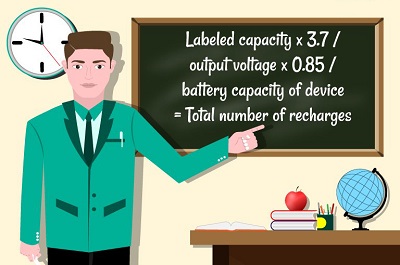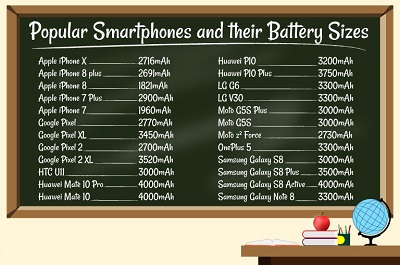How Many Times Can My Power Bank Recharge a Phone?
Time:2018-07-26
Views:2315
How Many Times Can My Power Bank Recharge a Phone?
.jpg)
We are typically exposed to somewhere between 4000 to 10,000 advertisements per day. Many of these come in the form of packaging – bold claims by manufacturers of the ability and performance specs of their products. For example, your cereal will now often proclaim that it has all your daily essential vitamins and nutrients. In the world of power banks, however, the most often cited indicator used is that of charge capacity – how many times will your power bank charge an external device? But how are these numbers created? Today, we will explore the formula behind charge performance in power banks so that you’re armed with the best possible knowledge base when buying a new product.

The Math
While math may not be the most exciting subject in school (rocket ship designers might disagree), it’s important to understand how exactly a manufacturer calculates the number of times their power bank will charge your cellphone. Here’s the formula they rely on:
(Labeled capacity of the power bank x 3.7 / output voltage of power bank) x 0.85 / battery capacity of device = Total number of recharges
With this in mind, let’s look at this in a couple of examples. First up, the iPhone X, which has a battery size of 2,716mAh, which is the largest out of all the iOS devices. With the formula, you would be able to expect up to 4.6 recharges from 20,000mah power bank. Obviously, older models will have much higher recharges than newer models..
(20,000 x 3.7 / 5) x 0.85 / 2,716 = 4.6 charges
For the new Galaxy S9 (3,500 mAh) I’ll give another example. I’ll use the same example for a 20,000 mAh power bank with an output of 5V.
(20,000 x 3.7 / 5) x 0.85 / 3,500 = 3.5 charges

Note:
You cannot use this formula if you are charging your device with a USB-C PD port in a charging port. This is because the output changes according to the phone’s input needs. It’s not set like other power banks. However, you can use 5V as a reference.
The Details
Okay, so we’ve given you a formula, but what does it all mean? Let’s start with the first multiplication number – 3.7. This is the average voltage that you find in a battery cell. Normally you calculate this number by finding the mid-point between a fully charged cell and cell cut off (when it’s empty), and it’s specific but not universal to all lithium-ion batteries. Li-ion batteries featuring cobalt average at about 3.6 while those with manganese hover at 3.7.
How about the next one – 5? We use this here as the average voltage output of a typical power bank. They can often range depending on output type (USB, fast charge, lightning) and internal electronics. Again, you can normally find these details in the product specifications of whatever it is you’re buying. If using the above formula, be sure to swap out the 5 for whatever that devices voltage output is.
After that we have 0.85, which is multiplied by the average output voltage above. 0.85 is the average efficiency of a power bank, meaning that you’ll never get 100% of the total expected output as advertised. This is due to two things. First, because power banks boost output voltage from the average of 3.7 to 5, energy is lost when moving through its circuitry. Adding to that energy is lost as heat during a transfer and within the smartphone itself when moving to the battery; you can expect about 85% efficiency due to wasted and lost voltage. Please note that 0.85% conversion rate varies between chargers.
Conclusion
Ta da! Just like that, you’re equipped with the knowledge and tools needed to see past those attractive marketing lines and find out for yourself the effectiveness of your power bank. The rechargeable battery world is now your oyster. Go out and explore!

